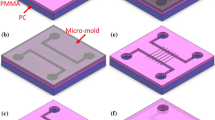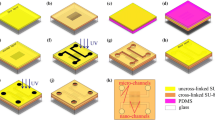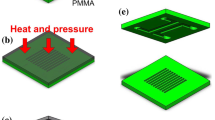Abstract
Nanofluidic chips are becoming increasingly important for biological and chemical applications due to the special phenomena only occur in nanochannels. In this study, a simple and low-cost method for fabricating SU-8 nanofluidic chips is proposed based on traditional ultraviolet (UV) photolithography. The thermal-induced cracks (nanochannels) can be automatically formed by thermal stress release during the postbake process. The influence of pattern-shape, pattern-angle and pattern-distance on the maximum stress of the SU-8 patterns was investigated. And the effect of postbake temperature on the maximum stress of the SU-8 patterns was also analyzed. The numerical and experimental results show that when the triangle SU-8 patterns with pattern-angle of 60° is postbaked at 125 °C, the nanocracks can be easily formed between two patterns. With this newly developed technology, simple, low-cost and large scale nanofluidic chips can be fabricated only by traditional UV photolighography, which allows a commercially manufacturing of nano-components.








Similar content being viewed by others
References
Cheng JY, Rettner CT, Sanders DP, Kim HC, Hinsberg WD (2008) Dense self-assembly on sparse chemical patterns: rectifying and multiplying lithographic patterns using block copolymers. Adv Mater 20(16):3155–3158
Chuanhua D, Wei W, Quan X (2013) Review article: fabrication of nanofluidic devices. Biomicrofluidics 7(2):026501
Chun D, Kim SH, Song H, Kwak S, Kim Y, Seok H, Lee S-M, Lee JH (2013) Fast myoglobin detection using nanofluidic electrokinetic trapping technique. Appl Phys Express 6(1):017001
Faustini M, Vayer M, Marmiroli B, Hillmyer M, Amenitsch H, Sinturel C, Grosso D (2010) Bottom-up approach toward titanosilicate mesoporous pillared planar nanochannels for nanofluidic applications. Chem Mater 22(20):5687–5694
Freedman KJ, Haq SR, Edel JB, Jemth P, Kim MJ (2013) Single molecule unfolding and stretching of protein domains inside a solid-state nanopore by electric field. Sci Rep 3:1638
Gillespie D, Pennathur S (2013) Separation of ions in nanofluidic channels with combined pressure-driven and electro-osmotic flow. Anal Chem 85(5):2991–2998
Hui Y, Yu L, Yi-ge Z, Feng-bin W, Feng-yun H, Xing-hua X (2008) A simple, disposable microfluidic device for rapid protein concentration and purification via direct-printing. Lab Chip 8(9):1496–1501
Ilic B, Czaplewski D, Zalalutdinov M, Schmidt B, Craighead HG (2002) Fabrication of flexible polymer tubes for micro and nanofluidic applications. J Vac Sci Technol, B 20(6):2459–2465
Lin P, Nakagawa W, Fainman Y (2003) Fabrication of optical structures using SU-8 photoresist and chemically assisted ion beam etching. Opt Eng 42(10):2912–2917
Lorenz H, Despont M, Fahrni N, LaBianca N, Renaud P, Vettiger P (1997) SU-8: a low-cost negative resist for MEMS. J Micromech Microeng 7(3):121–124
Menard LD, Ramsey JM (2011) Fabrication of sub-5 nm nanochannels in insulating substrates using focused ion beam milling. Nano Lett 11(2):512–517
Onses MS, Song C, Williamson L, Sutanto E, Ferreira PM, Alleyne AG, Nealey PF, Ahn H, Rogers JA (2013) Hierarchical patterns of three-dimensional block-copolymer films formed by electrohydrodynamic jet printing and self-assembly. Nat Nanotechnol 8(9):667–675
Pedersen JN, Marie R, Bauer DLV, Rasmussen KH, Yusuf M, Volpi EV, Kristensen A, Mir KU, Flyvbjerg H (2013) Fully streched single DNA molecules in a nanofluidic chip show large-scale structural variation. Biophys J 104(2):175A
Saleem MR, Stenberg PA, Khan MB, Khan ZM, Honkanen S, Turunen J (2012) HSQ resist for replication stamp in polymers. Adv Fabr Technol Micro/Nano Opt Photonics V 8249, Article no 82490G
Sang J, Du H, Wang W, Chu M, Wang Y, Li H, Zhang HA, Wu W, Li Z (2013) Protein sensing by nanofluidic crystal and its signal enhancement. Biomicrofluidics 7(2):024112
Shin S, Kim BS, Song J, Lee H, Cho HH (2012) A facile route for the fabrication of large-scale gate-all-around nanofluidic field-effect transistors with low leakage current. Lab Chip 12(14):2568–2574
Sivanesan P, Okamoto K, English D, Lee CS, DeVoe DL (2005) Polymer nanochannels fabricated by thermomechanical deformation for single-molecule analysis. Anal Chem 77(7):2252–2258
Sparreboom W, van den Berg A, Eijkel JCT (2009) Principles and applications of nanofluidic transport. Nat Nanotechnol 4(11):713–720
Tsukahara T (2010) Nanofluidic-based separation system of radionuclide ions by controlling electrostatic forces. Bull Res Lab Nucl React 34:51
van Kan JA, Zhang C, Malar PP, van der Maarel JRC (2012) High throughput fabrication of disposable nanofluidic lab-on-chip devices for single molecule studies. Biomicrofluidics 6(3):036502
Wu W, Walmsley RG, Li WD, Li X, Williams RS (2012) Nanoimprint lithography with <= 60 nm overlay precision. Appl Phys A Mater Sci Process 106(4):767–772
Xiangdong Y, Hongzhong L, Yucheng D (2009) Research on the cast molding process for high quality PDMS molds. Microelectron Eng 86(3):310–313
Yasui T, Kaji N, Ogawa R, Hashioka S, Tokeshi M, Horiike Y, Baba Y (2011) DNA separation in nanowall array chips. Anal Chem 83(17):6635–6640
Yunqiao W, Jun Z, Pun EYB (2011) Controllable fabrication of enclosed micro/nanochannels via polymethyl methacrylate pattern as sacrificial template and capillary effect. J Microlith Microfab Microsys 10(4):049701
Zhang YN, Reisner W (2015) Fabrication and characterization of nanopore-interfaced nanochannel devices. Nanotechnology 26(45):455301
Zhou K, Li L, Tan Z, Zlotnick A, Jacobson SC (2011) Characterization of hepatitis B virus capsids by resistive-pulse sensing. J Am Chem Soc 133(6):1618–1621
Acknowledgements
This project is supported by Specialized Research Fund for the Doctoral Program of Higher Education of China (SRFDP) (No. 20120041110034).
Author information
Authors and Affiliations
Corresponding author
Rights and permissions
About this article
Cite this article
Yin, Z., Lu, B. & Zou, H. A novel SU-8 nanofluidic chip fabrication technique based on traditional UV photolithography. Microsyst Technol 23, 5613–5619 (2017). https://doi.org/10.1007/s00542-017-3331-y
Received:
Accepted:
Published:
Issue Date:
DOI: https://doi.org/10.1007/s00542-017-3331-y




